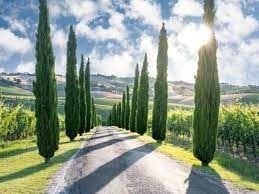Cypress is a genus vegetarian Arboreal family Sarwiya is one of its most important types Mediterranean cypress . Cypress contains a volatile oil that contains pinene Camphene Cedrol .
It is an ornamental tree with about fifteen species, all of which are characterized by their leafy structure and their buds covered with leaves . As for its leaves, they are evergreen , lanceolate , alternately scaly, rolled, and arranged in four rows. Its flowers are unisexual It is monoecious, the male flowers are compact, their number ranges between 6-14, and their seeds are small and winged. The cypress tree reaches a height of 30 meters. It is slow-growing and its wood is aromatic.
Etymology
The first appearance of the word cypress was in the Sumerian language with the word (shor-man), in the Assyrian-Babylonian Shurmenu, in the Phoenician brosh, in Hebrew brosh, in the Aramaic sharwina and brosh, in the Syriac sharwino, cypress, and proto, in Arabic suru, and in Persian suru.
The original home of the cypress
Its original habitat is Turkey and it is abundant in temperate climates, especially in the Levant and northern Iraq. It is also currently grown in all countries of the Mediterranean basin .
Use cypress
What is contained in this paragraph is not a prescription, but merely information
The use of cypress in modern medicine
It has been observed in modern medicine that when cypress is applied externally as a fat, it causes constriction of varicose veins and hemorrhoids and constricts blood vessels. When taken internally, cypress acts as an antispasmodic and a general tonic. It is prescribed for pertussis, spitting blood, and spastic cough. This treatment is also beneficial for colds, influenza, and sore throat.
The use of cypress in ancient medicine
The Greeks used cones crushed and soaked in wine to treat dysentery, spitting blood with coughs, asthma , and coughing .
Scientists have found some wood from this plant from the Sixth Dynasty and the Twelfth Dynasty in ancient Egypt. Cypress trees were also engraved on the outer walls of the Temple of Ramesses III in Karnak, as this plant was sacred and cypress trees still grow in the Arab Republic of Egypt. Christians call this type of plant the “sad tree” as a symbol of sadness and an adornment of graves.
The Pharaohs knew some types of cypress and it is believed that Noah's Ark was made of cypress wood.
The Pharaohs used the leaves of the cypress plant for several purposes, the most important of which was an ancient Pharaonic recipe for dyeing hair. The roots of the plant were used after crushing and kneading them with vinegar, then applying it to the hair of the head in the form of a poultice for the purpose of strengthening and dyeing it.
Ibn Sina said that cypress removes vitiligo, blackening of the hair. Its fresh leaves, along with walnuts and sycamores, are used for hernias if bandaged. If you crush cypress nuts finely with figs and use them as a wick in the nose, the excess flesh will be cured. Cooking it with vinegar relieves toothaches, it is useful for eye tumors as a bandage, it is permissible to drink it for dyspnea, erectile dysfunction, chronic cough, and it is beneficial for dysuria and intestinal and stomach ulcers.
As for David of Antioch, in his memoirs, he said: “Its gum heals wounds, completely retains blood, dries up sores wherever they are, dissolves tumors, and polishes traces, especially barhi, with paint and drink. Gargling with its hot stew soothes toothaches and gum ulcers and tightens their softness. Its soft fruit tightens the eyelids and heals hernias as food and bandage. It repels vermin with incense.” If it is kneaded with honey and licked, it will heal chronic coughs and strengthen the stomach. Its gum will cut off hemorrhoids. If the leaf and fruit of honey will be cooked with amla, water and vinegar until it disintegrates, then it will be cooked in oil and coated with it to make the hair black and long and prevent it from falling out. And with myrrh it will improve the bladder and prevent urination in bed.
As for Ibn al-Bitar in his collection, he says: “The leaves, stems, and nuts of this plant, as long as they are soft and soft, will wither away major wounds caused by solid objects. It is also used to treat anthrax, so they mix it with barley and water, or with vinegar mixed mixed with water. If he drinks its crushed leaves with paint and a little bit of myrrh, it will benefit the bladder, into which urine flows, and from dysuria.”

